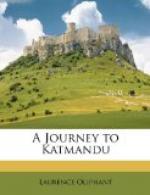How different was the peculiar yet handsome style which distinguished the dwellings of the Newar nobles at Patn from the tawdry glitter which characterises the mansions of the present Ghorka chiefs in the modern capital! Here the carving is more rich, the ornaments more massive, the houses themselves are more lofty and capacious. Sometimes two or three elaborately-carved balconies adorn the sombre but not less imposing exterior; from the projecting eaves wooden tassels, forming a sort of fringe, swing to and fro over the windows.
The roofs are beautifully tiled, each tile having a double curvature, while the corners of the buildings are quaintly turned up, giving a Chinese look to the building. The whole appearance of the houses and temples carries one far from the mud-huts or close cities of the plains of India, into the land of chopsticks and small feet, and the traveller feels much nearer to Pekin than to Calcutta as he wanders along the empty streets under the frowning houses and indescribable temples of the Newar town of Patn.
Everything seemed to have been blighted by time; besides all the old temples, old houses, old gates, and old streets, there were numbers of old people. Everything seemed to sympathise with everything else, and had evidently come to the conclusion that there was nothing worth living for, and the sooner they all took themselves off and quitted the bright valley of Nepaul the better. And indeed it was difficult to realize the existence of anything half so cheerful inside the town as the prospect which met our view as we emerged from its gloomy entrance, and looked upon the luxuriant plain, the glittering capital shining in its midst, whose gaudy pagodas, hung round with bells and adorned with flags, were very different from those just visited; the industrious population were going light-hearted to their work as we rode through smiling fields, and we ceased to wonder at Patn looking deserted, for it was evident that all the cheerfully disposed inhabitants had flitted away, unable to bear its depressing influence, and leaving behind them only the crabbed old people at the corners of the streets, and the tattered beggars, who must make a meagre livelihood out of the falling temples and 24,000 rotten houses of the once handsome capital of Nepaul.
It was a clear frosty morning, and, as we rode down the gentle slope on which the old city stands, the snowy range of the Himalaya burst upon us with inexpressible grandeur. The Gosain-than, a mass of glistening snow, looked contemptuously down upon the Jibjibia, itself covered with snow: though 13,000 feet lower than the Gosain-than, the Jibjibia in turn overtopped the Sheopoorie, which rises abruptly from the valley to a height of 2000 feet. On a peninsula, formed by the junction of the Bhagmutty and Bishmutty, stands the town of Katmandu, surrounded by a high wall in which are four gates: to the east the snow-capped peaks extend as far as the eye can reach; to the west the Dawalogiri, the highest mountain in the world, is in clear weather distinctly visible; in that direction the valley is shut in by lofty hills, the steepest of which is crossed by the Chandanagiri pass.




